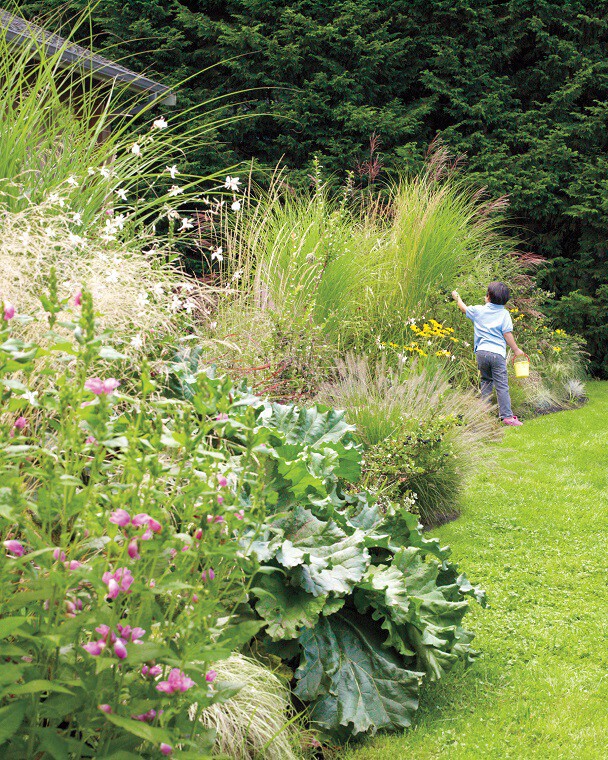In addition to adding plenty of texture and movement to your garden, they also serve an eco-friendly purpose.

For gardeners looking to add some texture and color to their plant palette, ornamental grasses perfectly fit the bill. These easy-care, adaptable plants come in a stunning variety of sizes, shapes, and shades, making them the perfect addition to any yard or garden. And as people become more and more interested in conserving natural resources and protecting pollinator populations, homeowners seem to be especially interested in mixing more ornamental grasses into their landscaping. Once established, many grasses need little additional water since their extensive root systems allow them to defy drought conditions. Plus, the dense nature of grasses and end of season seed heads provide shelter and food to wildlife
Xander Wessells, co-owner of Green Jeans Garden Supply in Mill Valley, California, first noticed a surge in popularity amongst environmentalists "who are dedicated to incorporating native grass species into their garden to sustain the insects, birds, and ecology that once thrived here." Ornamental grasses will most likely continue gaining interest as more striking and hardy varieties arrive on the market, and as more home gardeners find fun ways of introducing them into their garden spaces. As Wessells says, "There is nothing more sensuous than a well-established grass billowing in the wind." Here are some reasons and ways to add these beauties into your landscape.
They're Multitaskers
Avid gardeners know to add ornamental grasses to their landscaping because they do multiple jobs. They can look graceful, architectural, fit into most garden designs, and often provide year-round interest. Plus, planted singularly some can act like a punctuation mark; planted in mass, they become a long, thoughtful sentence.
Lawn Benefits
Ornamental grasses can make intriguing natural alternatives to traditional thirsty turf. Consider removing an existing lawn and planting a low-growing grass like a native no-mow fescue. Planting these grasses as a lawn takes less water, less maintenance, and is more environmentally friendly. Low growing grasses planted in mass also make ideal ground covers that smother weeds while also creating a unique texture.
They Work Well with Various Styles
With so many varieties of ornamental grasses to choose from, small to medium sized grasses-such as needle grasses (Stipa ssp.) or sedges (Carex spp.)-can be mixed with perennials and annuals for a dramatic or naturalistic feel. Also, most ornamental grasses can be blended into different garden themes like cottage, seaside, Asian, modern, and even drought tolerant. Pro tip: Before purchasing your grass, read the plant label carefully to determine if your choice needs little or lots of water, as well as what sort of exposure it prefers.
Provide Privacy
A large group of tall grasses can be a smart screening solution for an unpleasant view. For best effect, choose a large species such as Miscanthus transmorriensis (it can grow to four feet and is graced by arching five to six feet tall golden spikes that arch up and out from the foliage.) Remember to check ultimate sizes of your grass choices and place correctly so you can enjoy your grass for years to come without having to move them.
Add Gorgeous Texture
Ornamental grasses add unique texture to the landscape. Soft, billowy grasses such as fountain grass (Pennisetum spp.) look lovely contrasted with plants that have a bolder shape like flaxes (Phormium spp.). Or try strongly upright switchgrass (Panicum spp.) as a textural counterpart to more mounding shrubs like lavender. And whether it's patios, paving, walls, or other hardscapes that need softening, some ornamental grasses like mondo grass (Ophiopogon spp.) can take the edge off with their graceful, cascading blades.
The Perfect Fillers
Naturally clumping, low growing grasses make excellent edging plants for beds and borders or as textural filler for under specimen trees, sculptures, or fountains. For the most drama, choose one species and repeat. Japanese forest grass (Hakonechloa spp.) does this job well in a partly shady to fully shaded spot. Just know that this grass, like other deciduous perennial grasses, and will need to be cut back.
They Keep Going in the Fall
Extend the seasons by incorporating grasses that really shine in the fall when most annuals and perennials look tired and worn out. Many grasses like feather reed grass (Calamagrostis acutiflora 'Karl Foerster') doubles the interest with feathery plumes of shifting bronze color and then wheat-colored seed heads from mid-summer through fall.
Keep the Birds Happy
Native grasses fortunately help balance the ecosystem by providing shelter, food, and nesting sites for numerous pollinators, birds, and small mammals. By adding different layers of grasses and flowering plants to your garden, our furry, feathery, and winged friends can find the shelter and food they need to survive and thrive.